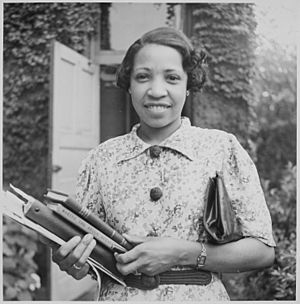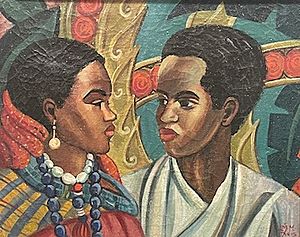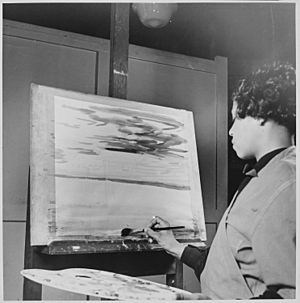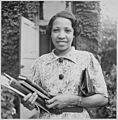Lois Mailou Jones facts for kids
Quick facts for kids
Lois Mailou Jones
|
|
|---|---|

Loïs Mailou Jones c. 1936
|
|
| Born | November 3, 1905 |
| Died | June 9, 1998 (aged 92) |
Lois Mailou Jones (1905-1998) was an amazing artist and a dedicated teacher. Her beautiful artwork can be seen in famous museums like the Smithsonian American Art Museum and The Metropolitan Museum of Art. She is often connected to the Harlem Renaissance, a time when African-American art and culture really blossomed.
Contents
Early Life and Art Education
Lois Mailou Jones was born in Boston, Massachusetts. Her father, Thomas Vreeland Jones, was the first African-American to get a law degree from Suffolk University Law School. Her mother, Carolyn Jones, was a cosmetologist, which means she worked with hair and makeup. Lois's parents always encouraged her to draw and paint with watercolors when she was a child.
They bought a house on Martha's Vineyard, an island where Lois met many people who inspired her. These included sculptor Meta Vaux Warrick Fuller, composer Harry Burleigh, and writer Dorothy West.
From 1919 to 1923, Lois went to the High School of Practical Arts in Boston. She also took night classes at the Museum of Fine Arts, Boston with a special scholarship. She even learned about costume design from Grace Ripley. At just seventeen, she had her first art show on Martha's Vineyard! During this time, she started using ideas from African masks in her designs.
Lois continued her studies at the School of the Museum of Fine Arts at Tufts in Boston from 1923 to 1927. She won a scholarship every year. She also took night classes at the Massachusetts College of Art and Design. After graduating in 1927, she earned another degree in design in 1928. She worked for design companies, but during a summer at Howard University in 1928, she decided to focus on painting instead of design.
Lois loved learning and kept taking classes throughout her life. In 1934, she studied different cultural masks at Columbia University. In 1945, she earned a bachelor's degree in art education from Howard University, graduating with high honors.
A Career of Art and Teaching
Lois Jones's career began in the 1930s and lasted until she passed away in 1998 at 92 years old. Her art style changed many times as she traveled and experienced new things. She used different art materials and methods, and her trips to Europe, Africa, and the Caribbean greatly influenced her work. She believed her biggest gift to the art world was showing "the talent of black artists." She wanted to be known simply as an American painter, without any labels. Her art truly showed her pride in her African roots and American heritage.
Starting as a Teacher and Artist (1928–1936)
Lois began teaching soon after college. In 1928, she was hired by Charlotte Hawkins Brown to start the art department at Palmer Memorial Institute, a school for black students in Sedalia, North Carolina. Besides teaching art, she coached basketball, taught folk dancing, and played piano for church services.
In 1930, she was invited to join the art department at Howard University in Washington, D.C. She stayed there as a professor of design and watercolor painting until she retired in 1977. She helped her students prepare for art careers by bringing in professional artists for workshops. While creating her own art, she also became a strong supporter of African-American art and artists.
In the early 1930s, Lois started showing her art. She exhibited a charcoal drawing called Negro Youth (1929). Around this time, she shifted from design to painting portraits.
Lois grew as an artist by visiting Harlem during the Harlem Renaissance, also known as the New Negro Movement. Artist Aaron Douglas influenced her important painting The Ascent of Ethiopia. Both Douglas and Jones used African design elements in their paintings. Lois studied actual African objects and designs.
In her works like Negro Youth and Ascent of Ethiopia, you can see the influence of African masks in the faces. The sharp lines and shading make them look like the three-dimensional masks Lois studied. She continued to use this style throughout her career.
She also worked with poet Gertrude P. McBrown. For example, McBrown's poem "Fire-Flies" appeared with an illustration by Jones in a magazine called Saturday Evening Quill in 1929.
Studying in Paris and New Inspirations (1937–1953)
In 1937, Lois received a special scholarship to study in Paris at the Académie Julian. She created over 30 watercolors during her year in France. She loved her time in Paris because she felt completely accepted there, unlike in the United States at that time. The French people truly appreciated art and talent.
In 1938, she painted Les Fétiches, an oil painting inspired by Africa. It is now at the Smithsonian American Art Museum. In Les Fétiches, five African masks seem to swirl on the dark canvas. Lois was able to see and study many different African objects and masks in Paris.
In 1941, Lois entered her painting Indian Shops Gay Head, Massachusetts into a competition at the Corcoran Gallery of Art. At that time, the Corcoran Gallery did not allow African-American artists to enter their own artworks. So, Lois had her friend Céline Marie Tabary submit the painting for her. Lois won an award for her art, but she couldn't pick it up herself. Tabary had to mail it to her. Despite these unfair rules, Lois worked even harder. In 1994, the Corcoran Gallery of Art publicly apologized to Lois Jones for this discrimination.
Jones's painting Les Fétiches was important for bringing the "Négritude" movement, which was mostly about writing, into visual art. Her work connected with writers like Aimé Césaire and Léopold Sédar Senghor. She also created Parisian Beggar Woman with words by Langston Hughes.

Lois painted "Arreau, Hautes-Pyrenees" in France during one of her many trips between 1945 and 1953. She shared a summer art studio with Céline Marie Tabary in Cabris, France. This oil painting shows a hillside in the South of France. It uses bright oranges, yellows, and tans with cool blues and greens, showing the influence of French art and Post-Impressionism.
Over the next ten years, Lois exhibited her art in many places, including The Phillips Collection, Seattle Art Museum, and Corcoran Gallery of Art. In 1952, a book called Loïs Mailou Jones: Peintures 1937–1951 was published, showing over a hundred of her paintings from France. She exhibited with famous black artists like Jacob Lawrence and Alma Thomas, who were known as the "Little Paris Group."
Alain Locke, a professor at Howard University and a founder of the Harlem Renaissance, encouraged Lois to paint about her heritage. After seeing a man walking in Washington, D.C., she painted Mob Victim (Meditation). She wanted to show the danger many African-American men faced in the 1940s.
In 1934, Lois met Louis Vergniaud Pierre-Noel, a famous Haitian artist, at Columbia University. They wrote to each other for almost 20 years before getting married in France in 1953. Lois and her husband lived in Washington, D.C. and Haiti. Their many trips to Haiti greatly changed Lois's art style.
Haitian Influence and African Travels (1954–1970)
In 1954, Lois was a visiting professor in Port-au-Prince, Haiti. The Haitian government invited her to paint the people and landscapes. Her art became full of bright, energetic colors. She and her husband returned to Haiti every summer for several years. Lois completed 42 paintings and showed them in an exhibition sponsored by the First Lady of Haiti. Because of her art, she received a special award from Haiti. In 1955, she painted portraits of the Haitian president and his wife, which were asked for by U.S. President Dwight D. Eisenhower.
Lois's many oil and watercolor paintings inspired by Haiti are some of her most famous works. In these, her love for bright colors, her understanding of Cubism, and her search for her own unique style reached their peak. You can see the influence of Haitian culture, with its African roots, in many of her pieces. Her art became more abstract, lively, and colorful after she started visiting Haiti.
In the 1960s, she exhibited her art at the School of the Museum of Fine Arts at Tufts, Cornell University, and galleries in France, New York, and Washington, D.C. In 1962, she started Howard University's first art student tour of France and led several more tours over the years.
In 1968, Lois received a research grant from Howard University to study contemporary Haitian artists. She received the same grant in 1970. Between 1968 and 1970, she traveled to 11 African countries, which greatly influenced her painting style. She interviewed and documented artists in places like Ethiopia, Sudan, Nigeria, and Ghana. Her report Contemporary African Art was published in 1970.
Later Years and Recognition (1971–1998)
On May 22, 1970, Lois Jones participated in a national protest day in Washington, D.C., against racism and the Vietnam War. While many artists in Washington, D.C., didn't make political art, Lois was deeply influenced by Africa and the Caribbean, and her art showed this. For example, her painting Moon Masque is thought to represent problems in Africa at the time.
In 1973, Lois received a grant for "Women artists of the Caribbean and Afro-American Artists." She also received an honorary Doctor of Philosophy degree.
Her research trips inspired Lois to combine African designs and patterns into large, detailed paintings. Her return to African themes in her later work matched the black expressionistic movement in the United States during the 1960s. Lois skillfully blended African masks, figures, and textiles into her vibrant paintings, connecting the Harlem Renaissance to a more modern expression of similar ideas.
On July 29, 1984, "Lois Jones Day" was declared in Washington, D.C., honoring her achievements.
Lois continued to create amazing new artworks at a fast pace. She traveled to France and experimented with her earlier Impressionist and Post-Impressionist styles. Her landscapes from this period used a wider range of colors, showing her Haitian and African influences.
On her 84th birthday, Lois had a major heart attack and later underwent heart surgery.
The Meridian International Center created a special exhibition of her work in 1990, which traveled across the country for several years. This exhibition was the first time Lois received nationwide attention. Even with her huge collection of art, her teaching career, and her cultural work, she had often been left out of history books because she didn't always paint subjects that were expected of African-American artists.
Bill Clinton and Hillary Clinton collected one of her island seascapes, Breezy Day at Gay Head, while they were in the White House.
In 1991, The National Museum of Women in the Arts held an exhibition that showed some of Lois's illustrations for children's books.
In 1994, The Corcoran Gallery of Art opened The World of Lois Mailou Jones exhibition. They also gave a public apology for their past racial discrimination against her.
In 1997, Lois's paintings were part of an exhibition called Explorations in the City of Light: African-American Artists in Paris 1945–1965. This show explored how important Paris was for African-American artists after World War II.
Lois Mailou Jones passed away in 1998 at her home in Washington, D.C., at the age of 92. She is buried on Martha's Vineyard. Howard University held an exhibition called Remembering Lois in her honor.
Lois Mailou Jones's Legacy
Lois Mailou Jones's artwork is in museums all over the world and is highly valued by art collectors. Her paintings are part of the permanent collections of the Metropolitan Museum of Art, Smithsonian American Art Museum, National Portrait Gallery, and the National Palace in Haiti, among many others.
After her death, her friend and adviser, Dr. Chris Chapman, wrote a book called Lois Mailou Jones: A life in color. The book tells about her life and the African-American pioneers she worked with and befriended, including Dr. Carter G. Woodson, Alain Locke, Dorothy West, and Josephine Baker.
The Lois Mailou Jones Pierre-Noel Trust created a scholarship in her name at the Museum of Fine Arts, Boston. They also set up a scholarship fund for the Fine Arts Department at Howard University.
In 2006, an exhibition called Lois Mailou Jones: The Early Works: Paintings and Patterns 1927–1937 opened at the School of the Museum of Fine Arts, Boston. It showed 30 designs and paintings from the beginning of her career.
From November 2009 to February 2010, a special exhibition of her work called Lois Mailou Jones: A Life in Vibrant Color was held at the Mint Museum of Art in Charlotte, North Carolina. This traveling exhibit included 70 paintings that showed her different styles and experiences from America, France, Haiti, and Africa.
Jones is also featured in the 2017 book Identity Unknown: Rediscovering Seven American Women Artists. Her work was included in the 2018 Columbus Museum of Art exhibition and catalog I too sing America: the Harlem Renaissance at 100.
Some of Lois Jones's students who became artists include Georgia Mills Jessup, Martha Jackson Jarvis, and David Driskell.
Awards and Honors
Lois Mailou Jones received many awards and honors throughout her life for her incredible art and contributions:
- Robert Woods Bliss Award for Landscape for Indian Shops Gay Head, Massachusetts (1941)
- Atlanta University award for watercolor painting Old House Near Frederick, Virginia (1942)
- Woman of 1946 award from the National Council of Negro Women (1946)
- John Hope Prize for Landscape for Ville d'Houdain, Pas-de-Calais (1949)
- Award from the Corcoran Gallery of Art for Petite Ville en hautes-Pyrenées (1949)
- Award from the Corcoran Gallery of Art for Coin de la Place Maubert, Paris (1953)
- Chevalier of the National Order of Honor and Merit from the government of Haiti (1954)
- Award for design of publication Voici Hätii (1958)
- America's National Museum of Art award for Fishing Smacks, Menemsha, Massachusetts (1960)
- Elected to The Royal Society of Arts in London (1962)
- Franz Bader Award for Oil Painting from National Museum of Art for Peasants on Parade (1962)
- Honorary Doctor of Philosophy from Colorado State University (1973)
- Howard University Fine Arts Faculty Award for Excellence in Teaching (1975)
- Honored by President Ronald Reagan at the White House for outstanding achievements in the arts (1980)
- Honorary Doctorate of Humane Letters from Suffolk University in Boston (1981)
- Candace Award, Arts and Letters, National Coalition of 100 Black Women (1982)
- Lois Jones Day, Washington, DC (July 29, 1987)
- Outstanding Achievement Award in the Visual Arts, Women's Caucus of Art, Cooper Union, New York, NY (1986)
- Honorary Doctorate in Fine Arts from Massachusetts College of Art, Boston (1986)
- Honorary Doctor of Humane Letters from Howard University (1987)
- Honorary Doctor of Fine Arts from the Corcoran School of Art (1996)
Selected Artworks in Collections
Lois Mailou Jones's art is held in many important collections around the world. Here are some examples:
- Men Working, not dated, Smithsonian American Art Museum, Washington, DC
- Negro Youth, 1929, Smithsonian American Art Museum, Washington, DC
- Brother Brown, 1931, Smithsonian American Art Museum, Washington, DC
- Les Fétiches, 1938, Smithsonian American Art Museum, Washington, DC
- Place du Tertre, 1938, The Phillips Collection, Washington, DC
- Dans un Café à Paris (Leigh Whipper), 1939, Brooklyn Museum, Brooklyn, NY
- Cauliflower and Pumpkin, 1938, The Metropolitan Museum of Art, New York, NY
- Self-Portrait, 1940, Smithsonian American Art Museum, Washington, DC
- Arreau, Hautes-Pyrénées, 1949, National Museum of Women in the Arts, Washington, DC
- Mme. Feugeront à Cabris, AM, 1950, Muscarelle Museum of Art, Williamsburg, VA
- Jeune Fille Française, 1951, Smithsonian American Art Museum, Washington, DC
- Eglise Saint Joseph, 1954, Smithsonian American Art Museum, Washington, DC
- Shapes and Colors, 1958, Smithsonian American Art Museum, Washington, DC
- Challenge—America, 1964, Hirshhorn Museum and Sculpture Garden, Washington, DC
- Moon Masque, 1971, Smithsonian American Art Museum, Washington, DC
- Ode to Kinshasa, 1972, National Museum of Women in the Arts, Washington, DC
- Ubi Girl from Tai Region, 1972, Museum of Fine Arts, Boston, Boston, MA
- La Baker, 1977, Museum of Fine Arts, Boston, Boston, MA
- The Green Door, 1981, National Gallery of Art, Washington, DC
- Suriname, 1982, Smithsonian American Art Museum, Washington, DC
- Glyphs, 1985, Museum of Fine Arts, Boston, Boston, MA
- Untitled (Portrait of Léopold Sédar Senghor), 1996, Minneapolis Institute of Art, Minneapolis, MN
Selected Exhibitions
Lois Mailou Jones's art was shown in many exhibitions throughout her career:
- Solo exhibition, 1937, Howard University, Washington, DC
- Solo exhibition, 1946, Barnett Aden Gallery, Washington, DC
- Solo exhibition, 1947, Lincoln University of the Commonwealth of Pennsylvania
- Solo exhibition, 1948, Whyte Gallery and Howard University, Washington, DC
- Solo exhibition, 1955, Pan American Union Building, Washington, DC
- Solo exhibition, 1961, Galerie International, New York, NY
- Solo exhibition, 1966, Galerie Soulanges, Paris, France
- Solo exhibition, 1967, Cornell University, Ithaca, NY
- Forty Years of Painting, 1972, Howard University Gallery of Art, Washington, DC
- Reflective Moments, 1973–1974, MFA, Boston, Boston, MA
- Six Distinguished Women Artists, 1976, Brooklyn Museum, New York, NY
- Solo exhibition, 1979, The Phillips Collection, Washington, DC
- The World of Loïs Mailou Jones, 1990–1996, The Meridian International Center, Toured throughout the nation
- The Art of Loïs Mailou Jones, 1991–1993, Bomani Art Gallery, San Francisco, CA
- The Life and Art of Lois Mailou Jones, 1994, Corcoran Gallery of Art, Washington, DC
- Loïs Mailou Jones: The Early Works: Paintings and Patterns 1927–1937, 2006, School of the Museum of Fine Arts, Boston, MA
- Lois Mailou Jones: A Life in Vibrant Color, 2009–2010, Mint Museum of Art, Charlotte, NC
- Full Spectrum: The Prolific Master within Loïs Mailou Jones, 2014–2015, DC Commission on the Arts and Humanities, Washington, DC
- The Life and Work of Lois Mailou Jones, 2015, Martha's Vineyard Museum, Edgartown, MA
Images for kids
See also
 In Spanish: Lois Mailou Jones para niños
In Spanish: Lois Mailou Jones para niños







